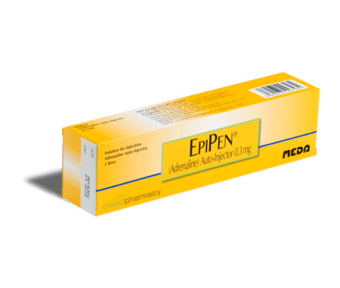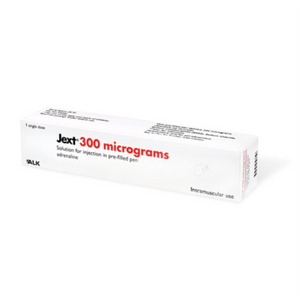Anaphylaxis

More information
Introduction
Anaphylaxis is a severe allergic reaction caused by an antigen. It is potentially life-threatening and can be triggered shortly after you are exposed to something you are allergic to. However, you can manage anaphylaxis if you identify and avoid triggers and carry an EpiPen with you at all times.
If you suffer from severe allergic reactions that can cause anaphylaxis, Cloud Pharmacy offers a selection of effective anaphylaxis treatments that are available through our online pharmacy, such as EpiPen and Jext.
As soon as your online consultation has been approved by one of our pharmacists, then we will send the treatment to you in a discreet package using our excellent courier service.
Treatments
More information
Once an online consultation has been been approved by our medical team, our pharmacy will safely prepare and ship your treatment to you in discreet packaging using Royal Mail or DPD.
What Is Anaphylaxis?
Anaphylaxis is a severe allergic reaction which results in a large release of chemicals by the immune system. It can cause you to go into shock and is potentially life-threatening. Exposure to potential triggers can cause anaphylactic shock, where your blood pressure will drop suddenly and your airways will narrow, making it difficult to breathe.
Potential triggers for anaphylaxis include food, insect bites and stings, and certain medication.
Anaphylaxis Symptoms
Anaphylaxis happens suddenly and can worsen quickly. Signs and symptoms of anaphylaxis include:
- Breathing difficulty
- Wheezing
- Lightheadedness
- Fast heartbeat
- Clammy or sweat skin
- Confusion
- Anxiety
- Losing consciousness
There could also be other allergy symptoms such as:
- Sickness
- Hives (an itchy, raised rash)
- Stomach pain or swelling
People who have anaphylaxis could go into anaphylactic shock. This is caused by the sudden flood of chemicals that are released by the immune system. When anaphylactic shock occurs, blood pressure drops significantly and the tissues in the bronchi - the two large tubes carrying air from your windpipe to your lung - swell. Anaphylactic shock can cause breathing difficulty, wheezing and loss of consciousness. If somebody has anaphylactic shock, they require immediate medical treatment to save their life.
Causes of Anaphylaxis
There are various potential causes and triggers of anaphylaxis, including:
- Food: nuts, fish, shellfish, milk, eggs and fruit all have the potential to trigger anaphylaxis. Proteins in some foods are capable of triggering anaphylaxis. These proteins are similar to those found in certain pollen.
- Insect stings and bites: anaphylaxis can be caused by the venom of some creatures such as wasps, bees and snakes.
- Medicines: such as some non-steroidal anti-inflammatory drugs (NSAID) and antibiotics. This may be linked to the binding of some drugs to a T cell (a white blood cell that belongs to the immune system) can cause a sudden chemical release when taking medicine for the first time.
- Latex: a material which items such as adhesive tape and disposable gloves are manufactured from. This happens when the immune system identifies latex as being harmful, and releases antibodies to combat it.
In some cases, there's no obvious trigger for anaphylaxis. When no cause can be identified, this is known as idiopathic anaphylaxis.
What to Do for Anaphylaxis
If someone is suffering from an anaphylactic shock or is experiencing symptoms, they need to be treated quickly. In this situation, there are several steps you can take, including:
- Administer an adrenaline auto-injector: if the person has this device and you understand how to use it, you can take it out of its package, remove its safety cap, and inject it into their mid-thigh.
- Call 999: seek immediate assistance, even if symptoms seem to be improving. Tell the emergency services that the person appears to have anaphylaxis.
- Remove any apparent trigger: if the trigger is still in contact with the person, such as a stinger from an insect, you can attempt to remove it.
- Lie the person down: lying the person down and elevating their legs can help ensure blood flow to vital organs. However, if the person is pregnant, they should lie on their left side, and if they are having breathing problems, they should sit up.
- Use the adrenaline auto-injector again: if you have an adrenaline auto-injector, you can administer a second injection after 5 minutes if symptoms haven’t improved.
How to use an EpiPen auto-injector
An EpiPen auto-injector is a type of adrenaline auto-injector. It is an injectable treatment for anaphylaxis or severe allergic reactions and is intended for emergency situations caused by anaphylactic reactions. After an EpiPen is administered, it is effective in constricting the blood vessels; increasing the blood pressure and reducing inflammation of the airways. This enables the lungs to open, which allows the person with anaphylaxis to breathe more easily.
The EpiPen requires an injection into the mid-thigh of the person with anaphylaxis. You shouldn’t use an EpiPen unless you have received the right training or familiarised yourself with the instructions. The instructions should be displayed on the side of every EpiPen. After removing the EpiPen from its package, the safety cap is taken off and the injection can be administered at a right angle into the thigh. The auto-injector should be pushed firmly until it clicks, then held in place for 3 seconds.
How Long Does Anaphylaxis Last?
Anaphylaxis develops quickly, and typically reaches the peak of its severity between 5 and 30 minutes. However, rarely, symptoms may return after a few hours, or days. If symptoms such as breathing difficulty, throat tightness and wheezing haven't subsided 5 minutes after having administered EpiPen, you should use a second adrenaline pen. Some symptoms – such as rash or stomach pain - can take longer to subside.
The effects of the adrenaline from your EpiPen injection usually wear off in 10 to 20 minutes, but the adrenaline can stay in your system for 6 hours or more.
Managing Anaphylaxis
There are ways of managing and living with anaphylaxis. You can also take steps to prevent anaphylaxis and ensure you are prepared if you do suffer from an allergic reaction. These measures include:
- Identify triggers: identifying allergy triggers is key to preventing anaphylaxis.
- Avoid triggers: once you have identified your triggers, when possible, you can stay away from substances that might cause anaphylaxis.
- Carry an anaphylaxis kit at all times: carrying an anaphylaxis kit or EpiPen means you are prepared for the event of anaphylaxis.
- Educate your friends and family: educating the people around you, such as family, friends and colleagues, on how to properly use an EpiPen could potentially be life-saving in the event of anaphylaxis.
What Should Be in an Anaphylaxis Kit?
If you are at risk of anaphylaxis, you should carry an anaphylaxis kit with you at all times. An anaphylaxis kit usually contains:
- 3 or more ampoules of adrenaline 1:1000
- 3 or more 1 mL syringes and 25 mm needles for injections
- Cotton wool swabs
Anaphylaxis Treatment
If you experience anaphylaxis, you may be prescribed an epinephrine (adrenaline) auto-injector. There are several different types of adrenaline auto-injector available, including:
You can purchase an EpiPen through Cloud Pharmacy's website after completing an online consultation. Once your suitability for EpiPen has been confirmed, we can deliver your items directly via our next-day delivery service.
Aside from adrenaline, other treatments which can be used during an anaphylactic attack include:
- Oxygen: to help breathing
- IV antihistamines: to reduce inflammation of the airways and help breathing
- Beta-agonists: to relax the muscles around the airways
There is no long-term treatment for the immune system condition that causes anaphylaxis. But you can prevent future attacks by staying away from your allergy triggers, and being well prepared for the event of an attack by carrying an EpiPen and an anaphylaxis kit.
Guides
How it works

First...
Complete a quick eligibility check

Then...
Order your treatment

Finally.
Fast, confidential delivery to your door


















